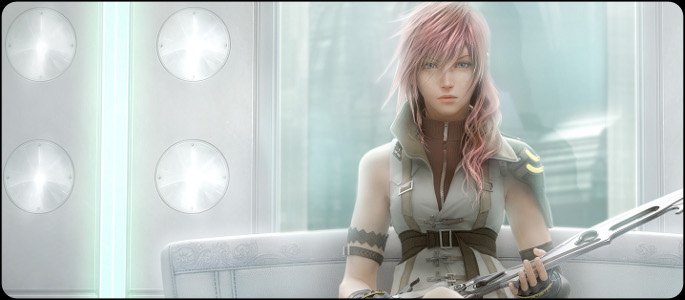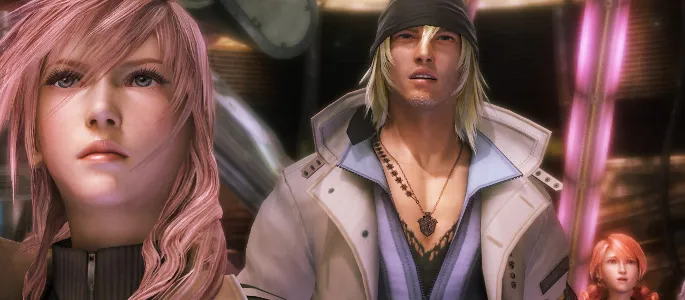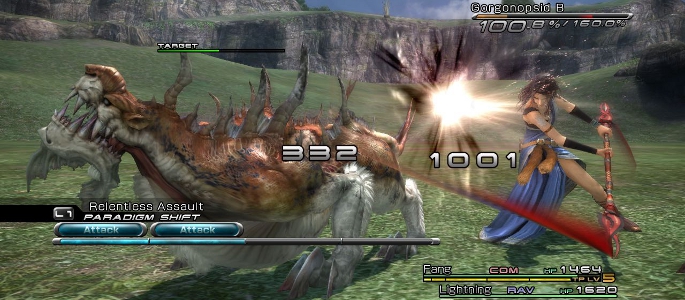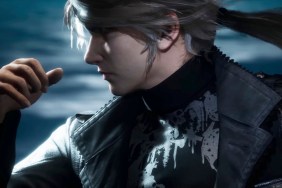
The latest chapter of Square Enix’s legendary Final Fantasy series is finally here. Final Fantasy XIII was announced nearly 4 years ago at E3 2006. Initially intended to be a PlayStation 2 title, Final Fantasy XIII accumulated over 5 years of development time. During these 5 long years of waiting, Final Fantasy and RPG fans worldwide have heavily anticipated the title as its release date seemed to push further and further into the future. Was the long wait worth it?
Final Fantasy XIII is set in the world of Pulse and its floating sister paradise Cocoon. Unlike previous Final Fantasy installments, while the story follows the ex-Guardian heroine named Lightning, there isn’t necessarily a “main character”. Instead, Final Fantasy XIII follows the story of Lightning and 5 other heroes that she meets throughout the story named Fang, Hope, Sazh, Snow and Vanille. Early in the game, Lightning and several of these main characters are subject to an exile from the floating city of Cocoon along with the other inhabitants. However, this major event becomes a point of contention since the heroes refuse to leave during the exile. It is during this time that the characters meet one another and begin the long conflict-filled story that tests the mettle of each character.
The story in Final Fantasy XIII is both well-presented and intriguing. While the journey starts with a simple beginning, the deep characters, great character interaction and action-packed events create for a splendid adventure through dozens of environments. The struggle to survive and battle to the next stage is truly felt through the emotion of each individual character. For a good portion of the game, the adventure remains largely predictable and consists of several battles followed by a boss and a cutscene. Fortunately, the story really does a great job of pulling in and making cutscenes feel like a reward for accomplishing each task. Each evolution of the story injects new interest into the characters and their adventure together.

Final Fantasy XIII is unlike any previous Final Fantasy title. Each character is able to be assigned a Paradigm which is basically a class. The Paradigms consist of Commando, Ravager, Sentinel, Synergist, Saboteur and Medic, each of which has its own capabilities as well as benefits for the party. Combat is mostly as simple as maintaining up to three characters in a party as they fight enemies. With the use of Paradigm Shift, the roles of each of the characters can be changed instantly in combat to any of the Paradigm Sets that have been configured in the party menu. While choosing the abilities to execute is possible, there is only the option of controlling the main character of the party. What this means is that combat is limited to selecting which attacks or abilities to use for the main character of the party as well as shifting between Paradigm Sets to counter enemy abilities and strengths.
The most surprising thing is that each Paradigm for the party leader has the option of using autocast. Basically what autocast does is let the player choose which enemy or friend to direct abilities to, and the CPU then chooses the abilities. Coupled with the Libra ability which scans the enemy for weaknesses, autocast usually does a better job than a player can. This is mostly due to the fact that the encounters are incredibly quick and actions must be selected in a timely manner. In many situations, selecting which abilities to use is better, but the time it takes to select them means less time spent monitoring the battlefield to adjust to split-second changes.

One gripe about Final Fantasy XIII is that a good portion of the game feels like an extended tutorial. The first 20 or so hours are up and down; sometimes the game is a lot of fun while sometimes it’s repetitive. This is largely due to the fact that the game isn’t particularly challenging early on, and therefore the quick tactics that make the combat so enjoyable are only seen during some of the moderately challenging fights and bosses. After about 20 hours the game spikes in difficulty and the combat becomes much more fast-paced and interesting. The reaction speed, timing and combat knowledge required make this arguably one of the best combat systems in any Final Fantasy title. While the 20 hour “tutorial” is definitely too lengthy, the combat is rather challenging, so a tutorial of sorts was definitely needed.
The great thing about Final Fantasy XIII’s combat is that it requires delicate balancing between offense, defense, and counters. During combat, all attacks boost a “chain gauge” on the enemy. While Commandos don’t boost the gauge much, they are great at keeping it from dropping back down. On the other hand Ravagers boost the gauge much more, but also have drop back. When the gauge reaches its max, the enemy is staggered and takes extra damage for a limited period of time. Due to this, there is a lot of strategy involved with deciding when to have damaging Paradigms out and when to have supporting roles out. The chain gauge is an incredibly important part of combat and many enemies are impossible to kill without balancing damage and survivability during combat.
Another reason combat is fierce and challenging is each and every fight in the game rewards based on how quickly the fight ended, and how well the player performed. If a fight ends before a certain amount of time expires and the player was quick and decisive, better spoils are rewarded after the battle. The difference between default and 5 star spoils are significant. The spoils are used to upgrade both weapons and accessories, both of which are the only equipment that can be selected. While upgrading is learned early on, it doesn’t become very important until the game spikes in difficulty later on. In terms of equipment, weapons and accessories are either purchased or found. In just about every case, both are obtained in raw form and once upgraded become much more powerful. It is worth noting that in order to obtain “Ultimate Weapons”, it is required that a level 1 weapon is fully upgraded with both upgrade materials and a rare material specific to each weapon.








